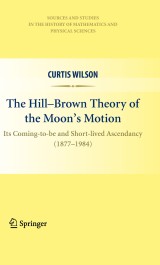Details

The Hill-Brown Theory of the Moon's Motion
Its Coming-to-be and Short-lived Ascendancy (1877-1984)Sources and Studies in the History of Mathematics and Physical Sciences
|
96,29 € |
|
| Verlag: | Springer |
| Format: | |
| Veröffentl.: | 03.06.2010 |
| ISBN/EAN: | 9781441959379 |
| Sprache: | englisch |
| Anzahl Seiten: | 323 |
Dieses eBook enthält ein Wasserzeichen.
Beschreibungen
The Hill–Brown theory of the Moon’s motion was constructed in the years from 1877 to 1908, and adopted as the basis for the lunar ephemerides in the nautical almanacs of the US, UK, Germany, France, and Spain beginning in 1923. At that time and for some decades afterward, it was the most accurate lunar theory ever constructed. Its accuracy was due, rst, to a novel choice of “intermediary orbit” or rst approxi- tion, more nearly closing in on the Moon’s actual motion than any elliptical orbit ever could, and secondly to the care and discernment and stick-to-it-ive-ness with which the further approximations (“perturbations” to this initial orbit) had been computed and assembled so as yield a nal theory approximating the Moon’s path in real space with an accuracy of a hundredth of an arc-second or better. The method by which the Hill–Brown lunar theory was developed held the potentiality for still greater accuracy. The intermediary orbit of the Hill–Brown theory may be described as a periodic solution of a simpli ed three-body problem, with numerical parameters carried to 15 decimal places. George William Hill, a young American mathematician working for the U. S. Nautical Almanac Of ce, had proposed it, and computed the numerical parameters to their 15 places. A self-effacing loner, he had in his privately pursued studies come to see that the contemporary attempts at predicting the Moon’s motion were guaranteed to fail in achieving a lunar ephemeris of the accuracy desired.
Hill Lays the Foundation (1877–1878).- George William Hill, Mathematician.- Lunar Theory from the 1740s to the 1870s – A Sketch.- Hill on the Motion of the Lunar Perigee.- Hill’s Variation Curve.- Early Assessments of Hill’s Lunar Theory.- Brown Completes the Theory (1892–1908), and Constructs Tables (1908–1919).- E. W. Brown, Celestial Mechanician.- First Papers and a Book.- Initiatives Inspired by John Couch Adams’ Papers.- Further Preliminaries to the Systematic Development.- Brown’s Lunar Treatise: Theory of the Motion of the Moon; Containing a New Calculation of the Expressions for the Coordinates of the Moon in Terms of the Time.- A Solution-Procedure Without Approximations.- The “Main Problem” Solved.- Correcting for the Idealizations: The Remaining Inequalities.- Direct Planetary Perturbations of the Moon (The Adams Prize Paper).- Indirect Planetary Perturbations of the Moon.- The Effect of the Figures of the Earth and Moon.- Perturbations of Order (?R)2.- The Tables.- Determining the Values of the Arbitrary Constants.- Ernest W. Brown as Theorist and Computer.- Revolutionary Developments in Time-Measurement,Computing, and Data-Collection.- Tidal Acceleration, Fluctuations, and the Earth’s Variable Rotation, to 1939.- The Quest for a Uniform Time: From Ephemeris Time to Atomic Time.- 1984: The Hill–Brown Theory is Replaced as the Basis of the Lunar Ephemerides.- The Mathematical and Philosophical Interest in an Analytic Solution of the Lunar Problem.
The Hill–Brown theory of lunar motion was, from its completion in 1908 to its retirement in 1984, the most accurate model of the moon’s orbit. The mathematical, philosophical, and historical interest in the analytic solution of the lunar problem using the Hill–Brown method still engages celestial mechanicians, and is the primary focus of this work.
This book, in three parts, describes three phases in the development of the modern theory and calculation of the Moon's motion. Part I explains the crisis in lunar theory in the 1870s that led G.W. Hill to lay a new foundation for an analytic solution, a preliminary orbit he called the "variational curve." Part II is devoted to E.W. Brown's completion of the new theory as a series of successive perturbations of Hill's variational curve. Part III describes the revolutionary developments in time-measurement and the determination of Earth-Moon and Earth-planet distances that led to the replacement of the Hill–Brown theory in 1984.
Although some calculus and differential equations are included, the text is largely accessible without advanced knowledge in these areas. Amateurs of astronomy, as well as instructors and scholars of the general history of science, will find this book of significant interest.
This book, in three parts, describes three phases in the development of the modern theory and calculation of the Moon's motion. Part I explains the crisis in lunar theory in the 1870s that led G.W. Hill to lay a new foundation for an analytic solution, a preliminary orbit he called the "variational curve." Part II is devoted to E.W. Brown's completion of the new theory as a series of successive perturbations of Hill's variational curve. Part III describes the revolutionary developments in time-measurement and the determination of Earth-Moon and Earth-planet distances that led to the replacement of the Hill–Brown theory in 1984.
Although some calculus and differential equations are included, the text is largely accessible without advanced knowledge in these areas. Amateurs of astronomy, as well as instructors and scholars of the general history of science, will find this book of significant interest.
Illustrates the complete history of the theory begun by G.W. Hill through to its completion by E.W. Brown Numerous historical accounts reveal how and why perspectives on the lunar problem have changed over time Uniquely present the set of lunar properties that made the moon a more difficult subject for celestial mechanicians than any other celestial body Provides elementary explanation of the dynamics involved in the Hill-Brown theory making the book accessible to the non-professional Includes supplementary material: sn.pub/extras

















